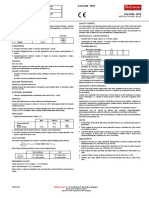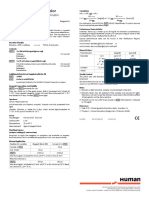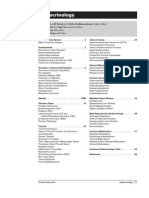Cholesterol LDL Direct
Cholesterol LDL Direct
Uploaded by
Risqon Anjahiranda AdiputraCopyright:
Available Formats
Cholesterol LDL Direct
Cholesterol LDL Direct
Uploaded by
Risqon Anjahiranda AdiputraOriginal Description:
Original Title
Copyright
Available Formats
Share this document
Did you find this document useful?
Is this content inappropriate?
Copyright:
Available Formats
Cholesterol LDL Direct
Cholesterol LDL Direct
Uploaded by
Risqon Anjahiranda AdiputraCopyright:
Available Formats
CHOLESTEROL LDL
COD 11585 1 x 80 mL
DIRECT
STORE AT 2-8ºC
Reagents for measurement of LDL cholesterol concentration CHOLESTEROL LDL DIRECT
Only for in vitro use in the clinical laboratory
DETERGENT
PRINCIPLE OF THE METHOD QUALITY CONTROL
A specific detergent solubilizes the cholesterol from high density lipoproteins (HDL), very low It is recommended to use the Lipid Control Serum level I (cod. 18040) and II (cod. 18041) to
density lipoproteins (VLDL) and chylomicrons. The cholesterol esters are broken down by verify the performance of the measurement procedure.
cholesterol esterase and cholesterol oxidase in a non-color forming reaction. The second Each laboratory should establish its own internal Quality Control scheme and procedures for
detergent, present in the reagent B, solubilizes cholesterol from low density lipoproteins (LDL) in corrective action if controls do not recover within the acceptable tolerances.
the sample. The LDL cholesterol is then spectrophotometrically measured by means of the
coupled reactions described below1. METROLOGICAL CHARACTERISTICS
chol. esterase
Cholesterol esters + H2O Cholesterol + Fatty acid − Detection limit: 0.28 mg/dL = 0.007 mmol/L
chol. oxidase − Linearity limit: 990 mg/dL = 25.6 mmol/L.
Cholesterol + ½ O2 + H2O Cholestenone + H2O2 − Repeatibility (within run):
peroxidase
Mean Concentration CV n
2 H2O2 + 4 – Aminoantipyrine + DSBmT Quinoneimine + 4 H2O
146 mg/dL = 3.78 mmol/L 0.7 % 20
CONTENTS AND COMPOSITION 210 mg/dL = 5.43 mmol/L 0.6 % 20
A. Reagent. 1 x 60 mL. MES buffer > 30 mmol/L, cholesterol esterase < 1.5 U/mL, cholesterol − Reproducibility (run to run):
oxidase < 1.5 U/mL, 4-aminoantipyrine 0.5 mmol/L, ascorbate oxidase < 3.0 U/L, peroxidase
Mean Concentration CV n
> 1 U/mL, detergent, pH 6.3.
143 mg/dL = 3.70 mmol/L 2.0 % 40
B. Reagent. 1 x 20 mL. MES buffer > 30 mmol/L, N,N-bis(4-sulfobutyl)-m-toluidine (DSBmT)
207 mg/dL = 5.35 mmol/L 1.7 % 40
1 mmol/L, detergent, pH 6.3.
S. HDL/LDL calibrator. Human serum. Concentration is given on the label. − Trueness: Results obtained with this reagent did not show systematic differences when
Components from human origin have been tested and found to be negative for the presence of compared with reference reagents . Details of the comparison experiments are available on
antibodies anti-HIV and anti-HCV, as well as for Hbs antigen. However, they should be handled request.
cautiously as potentially infectious. − Interferences: Lipemia (triglycerides 12.9 g/L), hemoglobin (5 g/L) and bilirubin (20 mg/dL) do
not interfere. Other drugs and substances may interfere3.
STORAGE
These metrological characteristics have been obtained using an analyzer. Results may vary if a
Store at 2-8ºC. different instrument or a manual procedure are used.
Reagents are stable until the expiry date shown on the label when stored tightly closed and if
contaminations are prevented during their use. DIAGNOSTIC CHARACTERISTICS
Indications of deterioration: Presence of particulate material, turbidity. LDL is the main lipoprotein transporting cholesterol from liver to tissues.
REAGENT PREPARATION Increased plasma LDL-cholesterol concentrations are positively correlated with the incidence of
atherosclerosic diseases, basis of myocardial infarction and cerebrovascular accidents4,5.
Reagents are provided ready to use.
HDL/LDL calibrator: reconstitute with 1.0 mL of distilled water . Stable for 1 week at 2-8ºC or for There are several disease states or environmental influences associated with increased levels of
2 months at –18ºC when frozen in aliquots. LDL-cholesterol: nephrosis, diabetes, obesity, some drugs and smoking4,5.
Clinical diagnosis should not be made on the findings of a single test result, but should integrate
ADDITIONAL EQUIPMENT both clinical and laboratory data.
− Thermostatic water bath at 37ºC
NOTES
− Analyzer, spectrophotometer or photometer with cell holder thermostatable at 37ºC and able
to read at (main wavelength) 546 ± 20 nm and (sub-wavelength) 700 nm ± 50 nm. 1. Sample and Reagent volumes may be varied as long as the same ratio is maintained.
2. These reagents may be used in several automatic analysers. Instructions for many of them
SAMPLES are available on request.
Serum, EDTA-treated plasma or sodium heparinized plasma collected by standard procedures.
BIBLIOGRAPHY
LDL cholesterol in serum is stable for 5 days at 2-8ºC.
1. Nauck M, Warnick GR, Rifai N. Methods for measurement of LDL-cholesterol: a critical
PROCEDURE assessment of direct measurement by homogeneous assays versus calculation. Clin Chem
2002; 48: 236-54.
1. Bring the Reagents and the photometer to 37ºC.
2. National Cholesterol Educarion Program Expert Panel. Third report of the National
2. Pipette into a cuvette: (Note 1) Cholesterol Education Program (NCEP) Expert Panel on Detection, Evaluation, and
Reagent A 750 µL
Treatment of High Blood Cholesterol in Adults (ATP III). NIH Publication. Bethesda: National
Serum/Calibrator 7 µL
Heart, Lung, and Blood Institute; 2001.
3. Young DS. Effects of drugs on clinical laboratory tests, 4th ed. AACC Press, 1995.
3. Mix and insert the cuvette into the photometer. Start the stopwatch. After 3-5 minutes, read
the absorbance (A1) at 546/700 nm against distilled water. 4. Tietz NW. Clinical guide to laboratory tests, 3rd ed. Saunders Co, 1999.
4. Pipette into a cuvette: 5. Friedman and Young. Effects of disease on clinical laboratory tests, 3th ed. AACC Press,
1997.
Reagent B 250 µL
Mix.
5. After 5 minutes, read the absorbance (A2) at 546/700 nm.
CALCULATIONS
The cholesterol LDL concentration is calculated using the following general formula:
(A2 – A1) Sample
x C Calibrator = C Sample
(A2 – A1) Calibrator
REFERENCE VALUES
The following uniform cut-off points have been established by the US National Cholesterol
Education Program and have also been adopted in many other countries for the evaluation of
coronary artery disease risk2.
Up to 100 mg/dL = 2.59 mmol/L Optimal
100-129 mg/dL = 2.59-3.34 mmol/L Near optimal/above optimal
130-159 mg/dL = 3.37-4.12 mmol/L Borderline High
160-189 mg/dL = 4.14 –4.90-mmol/L High
> 190 mg/dL = 4.92 mmol/L Very High
M11585i-0406 BioSystems S.A. Costa Brava 30, Barcelona (Spain)
Quality System certified according to
EN ISO 13485 and EN ISO 9001 standards
You might also like
- Maglumi Syphilis-en-EU-V8.1Document6 pagesMaglumi Syphilis-en-EU-V8.1Laboratoire Dr Mansouri Reghaia Alger100% (1)
- Cholesterol HDL Precipitating ReagentDocument1 pageCholesterol HDL Precipitating ReagentRisqon Anjahiranda Adiputra83% (6)
- SGPT (ALT) - Kit InsertDocument2 pagesSGPT (ALT) - Kit InsertDharmesh Patel100% (1)
- Calcium MTBDocument1 pageCalcium MTBRisqon Anjahiranda Adiputra75% (4)
- Aspartate Aminotransferase (Ast-Got)Document1 pageAspartate Aminotransferase (Ast-Got)Risqon Anjahiranda Adiputra100% (3)
- 21505IDocument1 page21505INisa Javadd100% (2)
- A Amylase DirectDocument1 pageA Amylase DirectRisqon Anjahiranda Adiputra0% (1)
- Urea (Ned Method) : CODE NO. PACK SIZE Reagent 1 Reagent 2 Reagent 3Document1 pageUrea (Ned Method) : CODE NO. PACK SIZE Reagent 1 Reagent 2 Reagent 3Dharmesh PatelNo ratings yet
- Bili Total RandoxDocument2 pagesBili Total RandoxJesus Guillermo Caceres Fernandez100% (6)
- Principle of The Method Metrological Characteristics: Bromocresol GreenDocument1 pagePrinciple of The Method Metrological Characteristics: Bromocresol GreenRisqon Anjahiranda Adiputra100% (2)
- Bilirubin (Total and Direct)Document1 pageBilirubin (Total and Direct)Risqon Anjahiranda Adiputra89% (9)
- Brosure MPR s163Document2 pagesBrosure MPR s163Risqon Anjahiranda AdiputraNo ratings yet
- Aspartate Aminotransferase (Ast-Got)Document1 pageAspartate Aminotransferase (Ast-Got)Risqon Anjahiranda Adiputra100% (3)
- Bilirubin (Total and Direct)Document1 pageBilirubin (Total and Direct)Risqon Anjahiranda Adiputra89% (9)
- Principle of The Method Metrological Characteristics: Bromocresol GreenDocument1 pagePrinciple of The Method Metrological Characteristics: Bromocresol GreenRisqon Anjahiranda Adiputra100% (2)
- Principle of The Method Quality Control: Alkaline PicrateDocument1 pagePrinciple of The Method Quality Control: Alkaline PicrateRisqon Anjahiranda Adiputra100% (2)
- 11503i PDFDocument1 page11503i PDFstevie watuna75% (4)
- Calcium MTBDocument1 pageCalcium MTBRisqon Anjahiranda AdiputraNo ratings yet
- 11505IDocument1 page11505ITrần Tiến ĐạtNo ratings yet
- 11521i PDFDocument1 page11521i PDFNisa Javadd0% (1)
- Cholesterol LDL Precipitating Reagent: Biosystems S.ADocument1 pageCholesterol LDL Precipitating Reagent: Biosystems S.Ajef1234321No ratings yet
- Cholesterol HDL DirectDocument1 pageCholesterol HDL DirectTrần Tiến ĐạtNo ratings yet
- Chol PDFDocument1 pageChol PDFTaqien AbscNo ratings yet
- Bab 8.1.2.11 Sop Pengolahan LimbahDocument1 pageBab 8.1.2.11 Sop Pengolahan Limbahrofi husaeni fahmiNo ratings yet
- CreatinineDocument1 pageCreatinineDesiNo ratings yet
- ALKALINE PHOSPHATASE LiquicolorDocument1 pageALKALINE PHOSPHATASE LiquicolorMaher0% (1)
- URIC ACID Liquicolor PlusDocument1 pageURIC ACID Liquicolor PlusMaher100% (1)
- auto-BILIRUBIN-T LiquicolorDocument1 pageauto-BILIRUBIN-T LiquicolorMaher100% (1)
- Alkaline Phosphatase (Alp) - DeaDocument1 pageAlkaline Phosphatase (Alp) - DeaRisqon Anjahiranda Adiputra100% (2)
- Bilirubin (Total and Direct)Document1 pageBilirubin (Total and Direct)Risqon Anjahiranda AdiputraNo ratings yet
- Creatine Kinase MB (CK MB)Document1 pageCreatine Kinase MB (CK MB)Risqon Anjahiranda Adiputra100% (3)
- Alanine Aminotransferase (Alt-Gpt)Document1 pageAlanine Aminotransferase (Alt-Gpt)Risqon Anjahiranda Adiputra50% (2)
- Alkaline Phosphatase (Alp) - AmpDocument1 pageAlkaline Phosphatase (Alp) - AmpRisqon Anjahiranda Adiputra100% (4)
- Urea Ingles PDFDocument1 pageUrea Ingles PDFcesiahdezNo ratings yet
- Insert Kit PemeriksaanDocument1 pageInsert Kit PemeriksaanNisa Javadd100% (2)
- Urea Liquiuv: GLDH Method Fully Enzymatic Method For Kinetic Determi-Nation of UreaDocument1 pageUrea Liquiuv: GLDH Method Fully Enzymatic Method For Kinetic Determi-Nation of UreaMaher100% (2)
- Calcium ArsenazoDocument1 pageCalcium ArsenazoYuni0% (1)
- Erba SGPTDocument2 pagesErba SGPTAnil Kumar50% (4)
- 11536i PDFDocument1 page11536i PDFdian saleh100% (1)
- Bilirubin Liquicolor: Photometric Colorimetric Test For Total Bilirubin DCA MethodDocument1 pageBilirubin Liquicolor: Photometric Colorimetric Test For Total Bilirubin DCA MethodMaherNo ratings yet
- BioSystems GGTDocument1 pageBioSystems GGTIvana BajunovicNo ratings yet
- HDL Direct Blt00028Document2 pagesHDL Direct Blt00028Pawan KulkarniNo ratings yet
- HbA1c Direct BiosystemDocument1 pageHbA1c Direct BiosystemSamar Sharaf67% (3)
- CK-MB Liquiuv: Liquid Nac Activated Uv Test Creatine Kinase (Ec 2.7.3.2)Document1 pageCK-MB Liquiuv: Liquid Nac Activated Uv Test Creatine Kinase (Ec 2.7.3.2)Maher100% (1)
- Aspartate Aminotransferase (Ast/Got)Document2 pagesAspartate Aminotransferase (Ast/Got)Ivana BajunovicNo ratings yet
- APTT AgappeDocument2 pagesAPTT AgappeDharmesh PatelNo ratings yet
- Erba TRIGLYCERIDESDocument2 pagesErba TRIGLYCERIDESPawan Kulkarni100% (1)
- Iiquicolor: Photometric Test For Calcium CPC MethodDocument1 pageIiquicolor: Photometric Test For Calcium CPC MethodMaherNo ratings yet
- Auto Liquicolor: Photometric Test For Direct (D) BilirubinDocument1 pageAuto Liquicolor: Photometric Test For Direct (D) BilirubinMaherNo ratings yet
- FT4 Free Thyroxine (CLIA) Catalog No. Package SizeDocument14 pagesFT4 Free Thyroxine (CLIA) Catalog No. Package SizeSinari AlfatNo ratings yet
- Bilirubin Total: ADL/V.02/110314Document1 pageBilirubin Total: ADL/V.02/110314S MNo ratings yet
- Uric Acid (Human)Document1 pageUric Acid (Human)m sdNo ratings yet
- Su Hba1cDocument1 pageSu Hba1cMaherNo ratings yet
- Erba URIC ACID DESDocument2 pagesErba URIC ACID DEShexamed bme100% (1)
- 066Document2 pages066Risqon Anjahiranda Adiputra75% (4)
- BilirubinbeaconDocument2 pagesBilirubinbeaconMalou Andersen100% (1)
- Bilirubin Jendrassik-Gróf FSDocument2 pagesBilirubin Jendrassik-Gróf FSErika Kusuma DaruNo ratings yet
- Ft4 Ii: Free ThyroxineDocument4 pagesFt4 Ii: Free Thyroxinehairi100% (1)
- CT10360Document4 pagesCT10360KOUAME EDYMAIN FRANCISNo ratings yet
- IFU - R920 e CHOL - 10 9Document2 pagesIFU - R920 e CHOL - 10 9Osama Ben DawNo ratings yet
- CT10240Document4 pagesCT10240Nguyễn HuynhNo ratings yet
- 159 CT10240Document2 pages159 CT10240thureinwinnNo ratings yet
- 173 CT10360Document2 pages173 CT10360thureinwinnNo ratings yet
- Clonatest Cholesterol MRDocument4 pagesClonatest Cholesterol MRSuprovet LabotatorioNo ratings yet
- Instrumen Cabinet KA 25Document1 pageInstrumen Cabinet KA 25Risqon Anjahiranda AdiputraNo ratings yet
- Spesifikasi - Intherma 168 PDFDocument2 pagesSpesifikasi - Intherma 168 PDFRisqon Anjahiranda AdiputraNo ratings yet
- Katalog C 28ADocument3 pagesKatalog C 28ARisqon Anjahiranda AdiputraNo ratings yet
- PMB Poltekkes 2019Document1 pagePMB Poltekkes 2019Risqon Anjahiranda AdiputraNo ratings yet
- Shutdown Procedure Erba XL 300: MaintenanceDocument2 pagesShutdown Procedure Erba XL 300: MaintenanceRisqon Anjahiranda AdiputraNo ratings yet
- Cholesterol LDL DirectDocument1 pageCholesterol LDL DirectRisqon Anjahiranda Adiputra0% (1)
- Brosure MPR s313Document2 pagesBrosure MPR s313Risqon Anjahiranda AdiputraNo ratings yet
- FRUCTOSAMINEDocument1 pageFRUCTOSAMINERisqon Anjahiranda AdiputraNo ratings yet
- Creatine Kinase MB (CK MB)Document1 pageCreatine Kinase MB (CK MB)Risqon Anjahiranda Adiputra100% (3)
- Cholesterol LDL DirectDocument1 pageCholesterol LDL DirectRisqon Anjahiranda AdiputraNo ratings yet
- Cholinesterase (Che)Document1 pageCholinesterase (Che)Risqon Anjahiranda AdiputraNo ratings yet
- Cholesterol LDL DirectDocument1 pageCholesterol LDL DirectRisqon Anjahiranda AdiputraNo ratings yet
- Bilirubin (Total and Direct)Document1 pageBilirubin (Total and Direct)Risqon Anjahiranda AdiputraNo ratings yet
- Patient Run: Erba Multi XL 300Document1 pagePatient Run: Erba Multi XL 300Risqon Anjahiranda AdiputraNo ratings yet
- BLK, QC, Cal RUNMultiDocument1 pageBLK, QC, Cal RUNMultiRisqon Anjahiranda AdiputraNo ratings yet
- Start Up Procedure Erba XL 300Document2 pagesStart Up Procedure Erba XL 300Risqon Anjahiranda AdiputraNo ratings yet
- Acid Phosphatase (Acp)Document1 pageAcid Phosphatase (Acp)Risqon Anjahiranda AdiputraNo ratings yet
- Alkaline Phosphatase (Alp) - DeaDocument1 pageAlkaline Phosphatase (Alp) - DeaRisqon Anjahiranda Adiputra100% (2)
- BLK, QC, Cal RUNMultiDocument1 pageBLK, QC, Cal RUNMultiRisqon Anjahiranda AdiputraNo ratings yet
- Alkaline Phosphatase (Alp) - AmpDocument1 pageAlkaline Phosphatase (Alp) - AmpRisqon Anjahiranda Adiputra100% (4)
- Alanine Aminotransferase (Alt-Gpt)Document1 pageAlanine Aminotransferase (Alt-Gpt)Risqon Anjahiranda Adiputra50% (2)
- Case Study QuestionsDocument35 pagesCase Study QuestionsazeemNo ratings yet
- ADM FINAL PE 2nd Quarter Week 6 To 9Document33 pagesADM FINAL PE 2nd Quarter Week 6 To 9Jhon Vincent GaytaNo ratings yet
- Circresaha 119 312617Document14 pagesCircresaha 119 312617Andrianna NastasyaNo ratings yet
- Nutrition A Functional Approach Canadian 3rd Edition Thompson Solutions Manual DownloadDocument11 pagesNutrition A Functional Approach Canadian 3rd Edition Thompson Solutions Manual DownloadStanley Dodson100% (19)
- Compact Yet Robust: Chemistry AnalyzerDocument4 pagesCompact Yet Robust: Chemistry AnalyzerThiago GalloNo ratings yet
- Tdiagnostics - Telangana.gov - in ViewFiles - Aspx ReportId BRVkypw98O5a6dg2ISpbjADocument5 pagesTdiagnostics - Telangana.gov - in ViewFiles - Aspx ReportId BRVkypw98O5a6dg2ISpbjAkingnag7203No ratings yet
- Yerba Mate - An Overview of Physiological Effects in HumansDocument13 pagesYerba Mate - An Overview of Physiological Effects in HumansJuanManuelCabarcosNo ratings yet
- Elitech Clinical Diagnostics CatalogueDocument10 pagesElitech Clinical Diagnostics Catalogueclinical_pathologyNo ratings yet
- Client Consultation and Health AppraisalDocument18 pagesClient Consultation and Health Appraisalgrande napaNo ratings yet
- Marfella NEJM 2024Document11 pagesMarfella NEJM 2024tristan_raoultNo ratings yet
- Management of Hypertriglyceridemia: Vinaya SimhaDocument19 pagesManagement of Hypertriglyceridemia: Vinaya SimhaJose S. M. TorrezNo ratings yet
- Exams MedsurgDocument29 pagesExams MedsurgUy Jezrielle MicahNo ratings yet
- Estudio Venezolano de Salud Cardio-Metabólica PDFDocument15 pagesEstudio Venezolano de Salud Cardio-Metabólica PDFCristóbal Graterol BarriosNo ratings yet
- Preparation of Soyabean Milk and Its Comparison With Natural Milk 2 PDFDocument18 pagesPreparation of Soyabean Milk and Its Comparison With Natural Milk 2 PDFDheeraj Kumar100% (1)
- KAPS APRIL, 3rd 2017Document12 pagesKAPS APRIL, 3rd 2017raju niraula100% (1)
- ESAP 2015 Laboratory Reference RangesDocument5 pagesESAP 2015 Laboratory Reference RangesFarhad AliNo ratings yet
- 3ef0b9f5 Cc1jurnalvco99Document36 pages3ef0b9f5 Cc1jurnalvco99Tasha FarahNo ratings yet
- Chapter 2 - NT2Document25 pagesChapter 2 - NT2Kathlene GamitNo ratings yet
- Interaction of Chenodeoxycholic Acid With Cholesterol in A Model System Studied by Spin Label Probe MethodDocument6 pagesInteraction of Chenodeoxycholic Acid With Cholesterol in A Model System Studied by Spin Label Probe MethodOpenaccess Research paperNo ratings yet
- YhjtDocument7 pagesYhjtkioontaghalNo ratings yet
- Blood Type Diet Chart PDFDocument20 pagesBlood Type Diet Chart PDFMarjon Velasco Dela Cerna IINo ratings yet
- Inborn Errors of Lipid MetabolismDocument41 pagesInborn Errors of Lipid MetabolismWalterNo ratings yet
- The Blueprint To Fasting For Fat Loss - V1.3 - 03-1-2023Document20 pagesThe Blueprint To Fasting For Fat Loss - V1.3 - 03-1-2023Riaan CoetzeeNo ratings yet
- Indian Perspective For Probiotics: A Review: ArticleDocument12 pagesIndian Perspective For Probiotics: A Review: ArticleMurali DathanNo ratings yet
- Your Brain Needs Cholesterol - David Perlmutter M.DDocument14 pagesYour Brain Needs Cholesterol - David Perlmutter M.DgfagragrehNo ratings yet
- 9 - Toronto Notes 2011 - EndocrinologyDocument56 pages9 - Toronto Notes 2011 - Endocrinologyarcsan15100% (1)
- Plasma Lipids, Lipoprotein & Apolipoprotein ProteinsDocument45 pagesPlasma Lipids, Lipoprotein & Apolipoprotein Proteinskiedd_04100% (5)
- L - 80148 LDL.01Document1 pageL - 80148 LDL.01mrashrafiNo ratings yet
- Comparative Study of Health (Metabolic Biomarkers) Between Owner Farmers and Farm Workers During The COVID-19 PandemicDocument8 pagesComparative Study of Health (Metabolic Biomarkers) Between Owner Farmers and Farm Workers During The COVID-19 PandemicIJPHSNo ratings yet
- CH 44 Antihyperlipidemics and Drugs To Improve Peripheral Blood FlowDocument5 pagesCH 44 Antihyperlipidemics and Drugs To Improve Peripheral Blood Flowaleenabinoy21No ratings yet









































































































